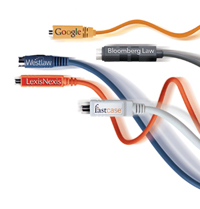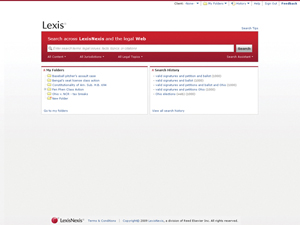Wired!

Illustration by Viktor Koen
There’s a battle about to break out on your computer screen. On the third floor of West’s sprawling corporate headquarters outside Minneapolis, a veritable army of professionals has been working for nearly five years to create a revamped Westlaw. They are changing everything from the interface users see on their PC screens to all the technology that makes it work behind the scenes.
Known as WestlawNext, the new platform will debut this month.
On its own suburban campus near Dayton, Ohio, LexisNexis—the other half of the duopoly that has ruled online legal research for almost 40 years (some call it “Wexis”)—is planning its own revamped platform. Referred to internally as New Lexis, it is slated to roll out publicly later this year on a date yet to be determined.
Both companies claim to be creating a legal research experience that will mimic the ease of use their customers have come to expect from the leading Internet search engine, Google.
The updated services come not a moment too soon, since the Mountain View, Calif.-based search engine has just gotten into the legal research business. In November, the company announced that its Scholar search engine now contains more than 80 years of U.S. case law from federal and state courts, as well as U.S. Supreme Court decisions dating back to 1791—all of it free.
Like a handful of smaller legal research companies that mostly serve solo practitioners and smaller law firms, Google built its service by aggregating the case law made available on the Internet by courts nationwide in recent years. Those companies have been slowly but surely nipping at the heels of West and LexisNexis at the low end of the market, where customers are most price-sensitive. With Google joining them, that price pressure is likely only to grow.
Wexis is also about to face a formidable competitor at the top end of the market. Bloomberg, the Manhattan-based financial information powerhouse, will introduce a revamped legal research product of its own later this year. Bloomberg Law is expected to be most attractive to the nation’s largest firms, which might want to research clients, prospective clients and the deals they do using Bloomberg’s world-class financial services databases.
Most of those same law firms currently use both Westlaw and Lexis. Will Bloomberg’s product be so enticing that it will prompt them to drop one or another of the Big Two?
After decades of Westlaw and Lexis rolling out incremental improvements, real innovation has become the watchword in online legal research. At stake: billions in revenue and a big piece of your computer desktop.
FAT AND HAPPY NO MORE
The prospect of increased competition leading to lower costs couldn’t come at a better time for the nation’s law firms.
“The party is over for our industry,” says David Curle, a Minneapolis-based analyst who covers the legal research and publishing industry for Outsell Inc., an advisory firm focused on the publishing and information industries. Law firms “had incredible growth and success and profits and got fat and happy. This economy pulled the rug out from under them.”
Revenues at the major legal research companies have also been affected by the Great Recession, but not equally so.
According to a presentation to Wall Street analysts by Anglo-Dutch parent company Reed Elsevier, during the first six months of 2009, LexisNexis’ U.S. legal markets business saw its revenues drop 5 percent. During the remainder of ’09, the unit “has seen a continuation of the first-half trends,” according to a November press release, which did not include exact revenue numbers. Online revenues of all sorts constitute 85 percent of the unit’s total revenues, according to the company.

WestLaw Next
Over at West’s parent, Thomson Reuters, legal unit revenues for the first three quarters of 2009 rose 1 percent compared to the same period in 2008, chief financial officer Robert Daleo told Wall Street analysts. Legal unit revenues dipped 1 percent in the third quarter, while the unit’s operating profits dropped 5 percent during the same period. But Westlaw revenues, when viewed alone during the third quarter, actually rose 3 percent, compared to Q3 2008.
Curle’s latest forecast for financial growth in the legal information industry is the lowest it has ever been—just below 2 percent. Historically, the industry has enjoyed annual growth rates of 5 to 7 percent. “It’s all about the overall economy, which is affecting law firm revenue, which leads firms to cutting back expenses,” he says.
In a 2009 survey of law firm librarians, Outsell found they expect their budgets to be flat for the next year, Curle says. “A flat budget in a period when lots of things are getting more expensive is hard.”
To the companies’ clients—some of which have seen double-digit drops in profits per partner over the last year—those numbers may look quite good. But for the main players like West and LexisNexis, Curle says, “it’s a tough period.”
Michael Walsh, president and CEO for U.S. legal markets at LexisNexis, says this is the type of economic climate where his company can prove its value to lawyers. “What Lexis is focused on is opportunities to capitalize on this acute awareness of firms as to what really matters now. We are looking at the recession as a great opportunity for us. We are making unprecedented investments.
“We obviously look at this as a very solid industry that is going through a very rough patch in an overall history of really good, solid expansion,” Walsh says. He is convinced that the legal industry will bounce back as soon as the second half of 2010.

Peter Warwick
Photo by Tim Pearson
Peter Warwick, chief executive of Thomson Reuters’ legal unit, allows that “the demand for legal services is less, so that helps to drive what goes on in legal research. Clearly we are impacted by that as a whole, which is to say that there isn’t the same underlying rate of growth in our business as there was a year ago.” Warwick’s eye is on the prize of increasing market share. To accomplish that goal, he says, his company must make sure it is offering a product that lawyers want. “There’s less growth in the market than we’ve seen for a number of years,” Warwick says, “but the need for the type of products and services that we have has never been stronger.”
GOOGLE-IZING LEGAL RESEARCH
To lawyers working at their PCs, the industry’s new products will look very much like the Google-ization of legal research. The product developers and engineers at legal search companies are acutely aware of the need to be more like Google when it comes to ease of use and search result relevance.
“Our new search engine is radically different,” says Marty Kilmer, vice president for new product strategy at LexisNexis. “Under the old system you had to know what you wanted to search. You had to drill down to find the right databases.”
Kilmer says attorneys made it clear that they wanted something simpler to use and better ways to know when they’ve exhausted their research options.
An early preview of the New Lexis opens with a simple query box. Boolean search terms—like “Roe and Wade” or “Scalia or Roberts”—are a thing of the past. Users can type a simple query with natural language, a la Google or Yahoo. Queries can be filtered by jurisdiction, type of content or other restrictions. The search engine, like Google, has artificial intelligence that will help pull more relevant results.
And the results are not just pulled from Lexis’ proprietary databases. According to Kilmer, users can obtain results from tens of thousands of legal websites Lexis has identified on the open Web. Those results will also be filtered for relevance, Kilmer says.
More significantly, the search results obtained from the New Lexis are displayed and organized in a vastly different manner than before. Windows along the sides display relevant results organized into folders such as cases, statutes and regulations. Users can sort the results in a variety of intuitive ways.
Scroll over the case name, and brief summaries pop up. Shepard’s citation service is incorporated into each case and even can be viewed graphically. Cases are plotted on a graph with axes for time and court level. Points on the graph relate to the central case as either relevant points of law or relevant legal issues.
The goal is to give users the most precise results in the most efficient manner, Kilmer says.

LexisNexis
New Lexis also promises tools for collaboration, allowing users to store results in work folders for later reference.
Over at West, the retooled Westlaw platform is also aiming to be easier to use and more aesthetically pleasing. Product development executives say they spent hundreds of hours watching attorneys do research and getting feedback on their existing product.
Mike Dahn, vice president of new product development of Thomson Reuters’ legal division, says the company’s research showed that lawyers often did not scroll beyond the first page or two of results to find the content they wanted. Instead, they would continue to rerun searches, generating costly bills.
A preview of WestlawNext also reveals it no longer requires users to learn the structure of its underlying databases. Instead, it allows users to enter a simple search term in natural language. As of late December, the company was debating whether to eliminate Boolean searches from the new platform or keep them as an option.
Searches can be narrowed by jurisdiction, type of content or other features, and artificial intelligence is used to help pull relevant results. Search results are returned in a list, but windows also appear sorting by content type—such as cases, statutes or legislation. The new platform also allows users to bookmark favorite databases and to track those they use most frequently. Westlaw’s KeyCite results—its counterpart to Shepard’s—are also incorporated into the results.
WestlawNext promises tools for workflow collaboration. Results can be saved in a folder and sorted by the client they were conducted for. Users will see when they last reviewed a saved case or statute, and numerous bells and whistles will allow users to search saved cases, highlight portions of them and even add their own notes.

Ed Walters
Photo by Ron Aira
A COMPETITIVE NUDGE
Ed Walters, CEO of Fastcase, a 10-year-old legal research and information provider in Washington, D.C., says his company has thrived because it already addressed the problems that LexisNexis and West are now trying to correct. “In the old way of doing legal research you get this long list of results and the results are undifferentiated. It’s one-size-fits-all,” he says. “That’s a huge problem.”
Fastcase sorts results from best to worst and citation analysis is built into the results. The results also can be sorted with a “four-dimensional graphical map” that helps users see the answers to the search.
In addition to selling its services to individual lawyers and firms, Fastcase counts 17 state bar associations and a variety of local bars as clients. In some instances, bar members receive access to all of Fastcase’s databases for free; in others, they are given access to their state’s case law and federal case law for free. Fastcase then upsells members on access to the cases of the other 49 states. More than 380,000 lawyers nationwide have some free access through their bar associations, according to the company.
Executives at West and LexisNexis counter that their companies have moved beyond what Fastcase provides. Both point to a wealth of secondary sources—newspapers, magazines, treatises, law reviews and the like—that add context to their case law. (Secondary sources will be coming soon to Fastcase, Walters says.) They boast of more extensive case summaries, to help lawyers quickly find the authorities they need.
LexisNexis also maintains its new platform will go beyond mere legal research to integrate the services of a variety of legal business and technology companies it has acquired in recent years, allowing it to offer Web design, billing systems, workflow analysis and more.

Michael Walsh
Photo by Len Irish
Lexis is taking a broader approach to its business, says Walsh. “We are marrying our information and data with productivity tools.
“It’s no longer sufficient to just deliver searchable case law,” he says. “We have to delight our customers. What we have learned in the marketplace is that it is unlike any other market. It is amazing how many problems your customers have; and if you can solve them and solve them well, they are going to want your product.”
For example, the new Lexis platform will include productivity tools to help lawyers evaluate the likelihood of winning a case, the cost of winning, and the potential value to both lawyer and client. The company says its new platform also will pull information from some of its other product lines, including the Martindale-Hubbell lawyer directory, to help lawyers learn as much as possible about every participant in a trial or deal. “We have the content and the tools to do it,” Walsh says.
For challenger Bloomberg, this is the second time it has tried to expand into the legal market. In 2004, it began offering its “B-Law” research product, but it didn’t gain a foothold in the market because it was only served up on Bloomberg’s proprietary terminals.
The new Bloomberg Law, which the company has been quietly beta testing over the past year in law schools and a handful of law firms in the New York metropolitan area, fixes that problem. It can be accessed from any PC, and its citation analysis summaries and strength-of-authority indicators “graphically display the treatment of your case and allow you to easily see the extent to which subsequent courts have analyzed your case,” according to promotional materials. A company representative declined to comment on the product for this article.
Nancy Rine, director of library services at Fried, Frank, Harris, Shriver & Jacobson in New York City, gives Bloomberg Law high marks for ease of use because it is menu-driven. “It starts with what do you want to do—find a person, a case, a docket, news.”
Searches can be done in natural language and results are relevant, says Ryan McKeen, an East Hartford, Conn., attorney who is beta testing Bloomberg Law. As a practitioner at a smaller, general practice firm, he thinks the Bloomberg product is better-suited for those on Wall Street but still gives it high marks for ease of use and content.
But Bloomberg still lags behind in its secondary source materials, librarians say. Although marketing information promises a full library of proprietary data, that has yet to fully materialize in the beta version.
Stanford University law librarian Paul Lomio gives Bloomberg Law a mixed review. He believes Lexis and Westlaw may provide better search results than the Bloomberg product, but he likes other features such as its docket search functions. Lomio also gives high marks to Bloomberg’s collaboration features, which allow users to save results, annotate cases and share them with anyone.

Rich Klau
Photo by Thomas Broening
Google, meanwhile, is not trying to compete with the likes of West, LexisNexis, Bloomberg, Fastcase or any other commercial legal research company, says lawyer Rick Klau, a project manager at Google who helped build the Scholar database.
“There is no attempt to slay anyone here,” Klau says. “Google’s mission is to organize the world’s information and make it useful. This was a collection of content that was not accessible and well-organized.” He says Google Scholar was designed to make the information accessible for ordinary citizens. The company has no current plans to do more with the information than what is already available.
Google’s database allows users to search its content against any words, concepts or citations and will pull up opinions related to the searcher’s query. The results are ranked by relevance. Citations in the opinions are hyperlinked to other opinions. The results also provide links to other Google databases, such as books and law reviews, to help searchers get context.
But Google Scholar does not provide any sort of system to check the validity of the case, nor does it offer any type of taxonomy of the case.
Klau goes so far as to question the value of Google Scholar to practicing lawyers: “The two primary for-pay services provide tremendous value to their users and help you better understand and consume information, like whether an opinion is still valid. Those are things that practitioners rely on and will continue to rely on.”
Despite Klau’s protestations, others in the legal information sector are watching Google. “You are always very conscious of what Google is doing because the company has immense resources available,” says Warwick of Thomson Reuters.
TESTING THE LIMITS
Price—particularly during a recession—may be the ultimate competitive advantage. For the time being, the companies are mum on what the new platforms will cost lawyers. As of late December, West had not priced its new platform, but the company said when the platform is launched it will only be available as an upgrade. LexisNexis had not determined its pricing, but company representatives said many of the features on the new platform might be made available on an a la carte basis. Bloomberg declined to comment.
Walters of Fastcase says the others should pay attention to his company because it is proof of the power of the bottom line. Fastcase offers subscriptions for as little as $95 per month.
Then, of course, there is Google’s unbeatable price of free.
Assuming neither the new West nor LexisNexis platform delivers a knockout blow to the other, the most interesting competition may be where price matters least—at the top of the market with newcomer Bloomberg, some observers say.
At the biggest law firms, the companies may be testing the limits of how much information beyond pure legal research content is too much.
Fried Frank’s Rine may have already reached her limit. “It’s a challenge. You have to make such an investment in these products. And they keep adding more and more content, often duplicating what’s included in other services we already subscribe to. But we don’t necessarily need all that content, and we can’t continue paying different vendors for the same information,” she says.



